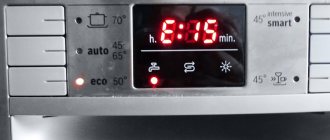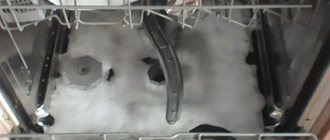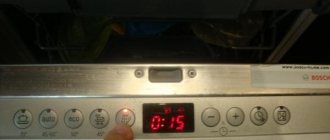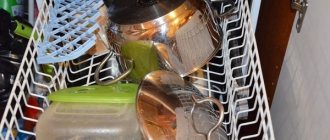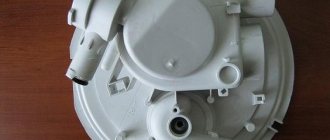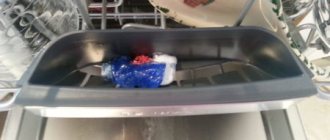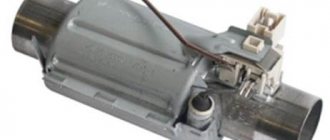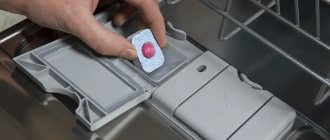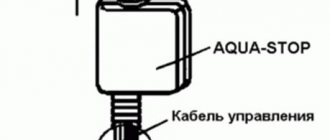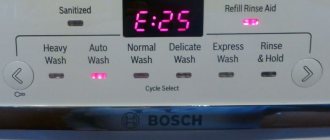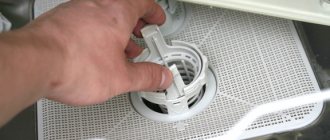Reasons for the appearance of error E1 in the dishwasher
There are many specific reasons for the error. The E1 designation appears in the car:
- if the water basically does not reach the chamber of the device, for example, due to low pressure in the water supply;
- if the pressure in the system is too strong, in a situation where the machine passes more water than necessary, its internal sensors report an error;
- if the level sensor is broken, in this case it will give incorrect readings even with normal liquid flow;
- if the inlet valve of the machine is faulty or the wiring going to it is damaged;
- if a blockage has formed in the drain system of the unit after prolonged use.
Error E1 in the Hansa dishwasher indicates that there is not enough water, or it is supplied in excess amounts. Tip! The Hansa dishwasher displays error E1 when the door is not tightly closed; in this case, the program will not start. Before you waste time on complex diagnostics, you need to make sure that the failure is not caused by the simplest reason.
What to do when an error code appears
When an error code appears, you need to refer to the instructions for the dishwasher to find its explanation and understand what the reason is and what exactly is wrong with the unit.
Contact VseRemont24 if:
- The instruction manual for your dishwasher “helper” is lost somewhere.
- You haven't fully understood the description of the error.
- You took independent actions to eliminate the problem, but they did not produce results.
- We realized that the dishwasher needs repairs, and you need the help of a professional and experienced technician.
Read also: Metal titanium - everything about it
Dishwasher malfunctions can be minor and can be fixed within a couple of minutes, but most of them require complex repairs.
Any external or internal part, as well as the entire unit of the dishwasher, can fail.
Failures of important components lead to the most common malfunctions:
- water leak,
- lack of dialing, draining water,
- no heating/overheating of water,
- insufficient amount of water,
- inconsistency of electrical network parameters with the necessary ones,
- program malfunctions,
- failure to perform individual functions or complete failure of the unit to work, and so on.
A faulty dishwasher works worse and does not wash dishes well. From a technology that saves water and electricity, it turns into an expensive “pleasure”. What is most important is that using a faulty electrical appliance is unsafe for people’s health and lives!
How to resolve error E1 in a Hansa dishwasher
In most cases, dealing with error E1 in the dishwasher is quite easy. It is necessary to inspect the elements responsible for draining and collecting liquid, as well as assess the quality of the water supply system.
How to check the water intake system
To inspect the intake system of the machine for blockages, first of all, you need to completely de-energize the device by unplugging it from the network. After this, they proceed according to the following algorithm:
- cut off the water supply;
- dismantle the intake hose - one end is unscrewed from the body, and the other from the water supply fitting;
- find a filter, it looks like a small thin grill located directly at the point where the dishwasher hose is attached;
- The element is carefully removed and cleaned of debris and accumulated fat.
Problems with water intake often occur due to clogging of the miniature filter of the inlet system.
If it is clear that the dishwasher filter is not just clogged, but damaged, it is better to replace it immediately, otherwise the problem will quickly arise again.
How to Inspect an Intake Valve
This element is located in the same place on the machine as the filter, so diagnostics are usually carried out in pairs. It is quite difficult to determine that the valve is damaged without the use of special tools. You can use a multimeter, set it to resistance measurement mode, disconnect all the wires from the terminals of the valve coil, and then apply the probes to the contacts. If the part is in working condition, the device will show 500-1500 Ohms. If the valve is faulty, then the measurements simply will not give results.
If the inlet valve malfunctions, the dishwasher stops drawing water normally
A failed valve cannot be repaired at home, and there is no point in taking it for repairs either. You need to buy exactly the same part for the Hansa machine in the store and install it in place of the broken one.
How to clean a dishwasher drain
The dishwasher shows E1 due to poor functioning of the drain system and constant water retention. Diagnostics and repairs are carried out as follows:
- the unit is disconnected from the power supply and water supply;
- remove the housing cover and remove the lower basket of the dishwasher;
- dismantle the drain element and clean it of adhering debris and grease;
- unscrew the screws securing the seat and pull out the damper;
- check whether debris has accumulated in the rotation zone of the impeller, and if necessary, clean its blades from dirt.
The drain system is located in the chamber under the dish basket.
After this, carry out all the steps in the reverse order, put the drain element in place and check whether the E1 error has stopped appearing in the Hans dishwasher.
How to check the functionality of the level sensor
Hans's dishwasher has a level sensor that determines the pressure and amount of water. If it malfunctions, error E1 often appears; the electronic system of the kitchen appliance cannot correctly record the volume of incoming liquid.
Diagnostics and repair of the sensor are carried out as follows:
- dismantle the left wall of Hans, having previously disconnected the unit from the outlet and water supply;
- drain the remaining water from the device tank;
- If possible, thoroughly clean the air tube suitable for the sensor; dirt, grease and small solid impurities that affect the operation of the controller are often retained in it.
The level sensor in the dishwasher is located next to the pump.
If the pressure switch itself is in working condition, then after cleaning the hollow tube, error E1 should be eliminated. If the sensor completely fails, all that remains is to replace it, but, according to user reviews, such a breakdown rarely occurs in a car.
How to adjust water pressure
The Hans dishwasher is designed to work with a specific water pressure. The sensor located inside the device is set to a pressure of 2.5-6 atmospheres. Since the pressure indicators in the main water supply of an apartment building are usually within these limits, there are usually no problems with using a dishwasher.
But if for some reason beyond the control of the user, the pressure in the pipes becomes higher and reaches 7-8 atm, the dishwashing device will not be able to function adequately. The valve begins to pass more liquid than necessary, the pressure switch detects a violation of operating conditions, and the dishwasher displays error E1. It will be impossible to use the kitchen appliance.
The pressure reducing valve maintains stable flow pressure at 3-4 atm
The most affordable way to solve a water pressure problem is to simply wait until the pressure in the pipes returns to normal values. But if changes occur too often, and the unit is used daily, to prevent error E1 it is easier to install a special pressure reducing valve; it is mounted in front of the machine’s inlet hose.
Decoding the code
Looking at the operating instructions for the Hansa dishwasher, we will see how clumsily the E4 error is deciphered by the manufacturer itself. Literally, the decoding is presented as follows: “overflow of water.” What kind of water overflow? Where could it have flown to? It seems that the operating instructions for such machines are compiled by employees of authorized service centers. Well, what if the user reads the instructions, doesn’t understand anything, and turns to the specialists who are happy to try to “rip off” a couple of large bills from the poor user.
Repairing a fault on a Hansa dishwasher associated with error E4 can cost $150-200, taking into account the cost of spare parts and the work of a technician.
Of course, on our part this is a joke, no one will deliberately squeeze money out of a user, but the problem has not gone away, it must be solved. What we have? Here is error E4, here is a certain overflow, which is mentioned in the instructions and there is no more information.
According to experts, the error with code E4 is caused by the fact that water filled the tray of the Hansa dishwasher, which triggered the protection in the form of the Aqua-Stop system, which in turn blocked the operation of the equipment. Now, without fixing the problem, or at least draining the water, the machine will not be able to start.
Possible causes of the error
Based on the detailed explanation of the E4 error that experts give us, this problem arises due to the fact that some part, tube or pipe inside the body of the Hans dishwasher has begun to leak. The tray of the machine is not that roomy. About a liter of water is enough for the float of the Aqua-Stop mechanism to rise, activate the sensor, and the machine stops working.
The pump, circulation system pipes, inlet hose or pipe may leak.
The list, in principle, can go on and on until you open the case and find out what exactly is leaking. However, one of our clients experienced an error with this code for the following reason. Let's start the story in order.
A couple of years ago, our regular client approached us with a problem. His Hansa machine did not work, and it not only refused to work, but gave an E4 error. The user himself came up with the idea that there was water in the pan of the car, and that this is why the error popped up. He drained the water, started the machine, but after 3 minutes it stopped again, and the same code was displayed on the display.
Our technicians came to the call and immediately dismantled the dishwasher. It turned out that the reason lay in the flown pipe of the circulation system. The factory clamp loosened and the pipe came off, causing water to flow unhindered into the pan. However, this is not even interesting. The very fact that the pressure pipe jumped out of its place does not represent anything remarkable, but what caused the excess pressure?
Here again we cannot do without some background. The fact is that our client, when he bought a dishwasher, decided to immediately start saving and instead of special salt for the dishwasher, he used ordinary “Extra” table salt for several years. This caused some of the salt in the tank to turn into a thick salt porridge, which created an obstacle to the passage of water and excess pressure.
As a result, if the pipe had not flown off and our craftsmen had not paid attention to this, the client would have ended up with expensive repairs over time. After all, excess pressure creates a load on the circulation pump, which will break down much faster. All in all, it still ended relatively well. The moral of this story is this: don’t skimp on it and the trouble described above will not happen to your car.
